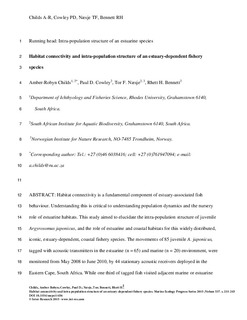| dc.description.abstract | Habitat connectivity is a fundamental component of estuary-associated fish behaviour. Understanding this is critical to understanding population dynamics and the nursery role of estuarine habitats. This study aimed to elucidate the intra-population structure of juvenile Argyrosomus japonicus and the role of estuarine and coastal habitats for this widely distributed, iconic, estuary-dependent, coastal fishery species. The movements of 85 juvenile A. japonicus, tagged with acoustic transmitters in the estuarine (n = 65) and marine (n = 20) environment, were monitored from May 2008 to June 2010 by 44 stationary acoustic receivers deployed in the Eastern Cape, South Africa. While one-third of the tagged fish visited adjacent marine or estuarine habitats, the majority exhibited high levels of residency to their respective estuarine or coastal tagging site. This high level of residency suggests that juvenile A. japonicus exist as a metapopulation with several non-dispersing subpopulations, each with distinct estuarine and marine contingents. The estuarine contingent had a higher recapture (mortality) rate (35%) than the marine contingent (20%), and within the estuarine contingent, the recapture rate was higher for resident individuals (41%) than migratory individuals (23%). Species with different contingents each exhibiting retentive and migratory/exploratory behaviours (i.e. partial migration) may therefore be more resilient to fishing pressure. Conversely, certain behavioural strategies, particularly estuarine residency, may be more vulnerable to exploitation, suggesting that management interventions are necessary in this habitat. This study demonstrates how ecological concepts should be incorporated to better describe diverse patterns in habitat use and migratory behaviour of estuarydependent species. Acoustic telemetry · Contingent theory · Estuary-dependent · Estuarine connectivity · Partial migration | nb_NO |
